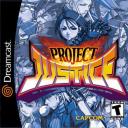Lost Classics: Project Justice (Arcade, Dreamcast)
by William Talley, filed in Games, Lost Classics on Apr.06, 2008
 This is the sequel to Capcom’s Rival Schools: United by Fate, one of the most underrated 3-d fighting games ever. Before Bully, Rival Schools and Project Justice made use of a high school setting, risking post some serious post-Columbine controversy. Thankfully, there was no big uproar, as the game was off-beat and hilarious instead of simply being violent. It made use of the same unique gameplay as its predecessor, and its presentation made served to make it one of the most unique fighting games available.
This is the sequel to Capcom’s Rival Schools: United by Fate, one of the most underrated 3-d fighting games ever. Before Bully, Rival Schools and Project Justice made use of a high school setting, risking post some serious post-Columbine controversy. Thankfully, there was no big uproar, as the game was off-beat and hilarious instead of simply being violent. It made use of the same unique gameplay as its predecessor, and its presentation made served to make it one of the most unique fighting games available.
As in the first game, you take control of one of several 3-man teams, each from a different school. You pick a fighter to start with, and the others are used to pull off assist attacks. Instead of only having two characters during a given round, all three characters are available, thereby making it possible to use the ‘Party Up’ technique, which is an assist attack making use of all three characters. It’s now possible to cancel out an assist attack as well. Upping the craziness level from the Rival Schools, the assist attacks range from a photographer snapping pictures and interviewing an opponent, a swim instructor doing a coordinated swim ballet, and even a verbal berating. There are two main single-player modes: Story and Free. Story mode has players select a school and progress through their storyline, complete with 2-d cutscenes. Free mode allows players to select any three characters and make their way through the game, being assigned a ranking at the end. Unfortunately, all the cool mini games from Rival Schools are gone, and the board game/create-a-character from the Japanese version of the game has been taken out due to the time it would have taken to translate it. Even with these short comings, Project Justice is still an enjoyable addition to any fighting game fan and Dreamcast owner’s library. Now I wish Capcom would make another game.


 PS3
PS3
 Famicom Dojo
Famicom Dojo KEEP PLAYING
KEEP PLAYING KEEP PLAYING: Rewind
KEEP PLAYING: Rewind Powet Toys
Powet Toys Powetcast
Powetcast Hitchhiker's Guide POWETcast
Hitchhiker's Guide POWETcast














